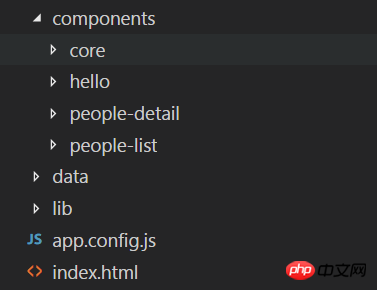Rumah >hujung hadapan web >tutorial js >在AngularJS中使用ui-route实现多层嵌套路由(详细教程)
在AngularJS中使用ui-route实现多层嵌套路由(详细教程)
- 亚连asal
- 2018-06-12 17:10:071860semak imbas
这篇文章主要介绍了AngularJS使用ui-route实现多层嵌套路由的示例,现在分享给大家,也给大家做个参考。
本文介绍了AngularJS使用ui-route实现多层嵌套路由的示例,分享给大家,具体如下:
一、预期实现效果:
https://liyuan-meng.github.io/uiRouter-app/index.html
(项目地址:https://github.com/liyuan-meng/uiRouter-app)
二、分析题目要求,给出依赖关系,构建项目
1. service:
(1)根据条件查询people数据checkPeople.service,不给出条件则查询所有。
(2)得到路由信息getStateParams.service。
2. components:
(1)hello模块:点击button按钮更改内容。
(2)peolpleList模块:显示people列表,点击people显示people详情。依赖于checkPeople.service模块。
(3)peopleDetail模块:显示people详情,依赖于checkPeople.service模块和getStateParams.service模块。
3. 构建项目:

如图所示:component目录用来保存所有服务模块和业务模块,lib目录保存外部引用(我是用的是angular.js1.5.8和ui-route0.2.18),app.config.js文件用来配置路由,index.html则作为入口文件。
三、实现这个例子
1. 首页index.html
<!DOCTYPE html> <html lang="en"> <head> <meta charset="UTF-8"> <title>Title</title> <script src="./lib/angular.js"></script> <script src="./lib/angular-ui-route.js"></script> <script src="./app.config.js"></script> <script src="./components/core/people/checkPeople.service.js"></script> <script src="./components/core/people/getStateParams.service.js"></script> <script src="./components/hello/hello.component.js"></script> <script src="./components/people-list/people-list.component.js"></script> <script src="./components/people-detail/people-detail.component.js"></script> </head> <body ng-app="helloSolarSystem"> <p> <a ui-sref="helloState">Hello</a> <a ui-sref="aboutState">About</a> <a ui-sref="peopleState">People</a> </p> <ui-view></ui-view> </body> </html>
(1)导入lib中的文件以及所有用到的service和component服务的文件。
(2)ng-app="helloSolarSystem"指明了从helloSolarSystem模块开始解析。
(3)定义视图5643c5c8ec46989a1440c123e54787f3142226fc0f7a4611fbee3f36258ad78a
2. 配置路由app.config.js
'use strict';
angular.module("helloSolarSystem", ['peopleList', 'peopleDetail', 'hello','ui.router']).
config(['$stateProvider', function ($stateProvider) {
$stateProvider.state('helloState', {
url: '/helloState',
template:'<hello></hello>'
}).state('aboutState', {
url: '/about',
template: '<h4>Its the UI-Router Hello Solar System app!</h4>'
}).state('peopleState', {
url: '/peopleList',
template:'<people-list></people-list>'
}).state('peopleState.details', {
url:'/detail/:id',
template: '<people-detail></people-detail>'
})
}
]);(1)模块名字:helloSolarSystem;
(2)注入'peopleList', 'peopleDetail', 'hello','ui.router'模块。
(3)配置stateProvider服务的视图控制,例如第一个名为helloState的视图控制器:当ui-sref == "helloState"的时候,路由更新为url的值#/helloState,并且5643c5c8ec46989a1440c123e54787f3142226fc0f7a4611fbee3f36258ad78a中显示的内容为5d31ad12eb7f2467fa10436b397d69f6ce2196d7bcfa28427152ee3efb4b3e34组件解析出的内容。
(4)嵌套路由的实现:名为peopleState的视图控制器是父路由。名为peopleState.details的视图控制器是子路由。这是一种相对路由方式,父路由将匹配.../index.html#/peopleState/,子路由将匹配.../index.html#/peopleState/detail/x(x是/detail/:id中的id的值)。如果改成绝对路由的形式,只需要写成url:'^/detail/:id',这时子路由将匹配.../index.html#/detail/x(x是/detail/:id中的id的值)。
4. 实现checkPeople.service(根据条件查找people)
checkPeople.sercice.js
'use strict';
//根据条件(参数)查找信息。
angular.module('people.checkPeople', ['ui.router']).
factory('CheckPeople', ['$http', function ($http) {
return {
getData: getData
};
function getData(filed) {
var people;
var promise = $http({
method: 'GET',
url: './data/people.json'
}).then(function (response) {
if (filed) {
people = response.data.filter(function (value) {
if (Number(value.id) === Number(filed)) {
return value;
}
})
} else {
people = response.data;
}
return people;
});
return promise;
}
}]);(1)在getData这个函数中,我们想要返回一个保存people信息的数组,但是由于使用$http().then()服务的时候,这是一个异步请求,我们并不知道请求什么时候结束,所以世界返回people数组是有问题的。我们注意到,$http().then()是一个Promise对象,所以我们可以想到直接将这个对象返回,这样在就可以使用"函数的结果.then(function(data))"来得到异步请求拿来的数据data。
3. 实现getStateParams.service(获取路由信息)
getStatePatams.service.js
"use strict";
angular.module("getStateParams", ['ui.router']).
factory("GetStateParams", ["$location", function ($location) {
return {
getParams: getParams
};
function getParams() {
var partUrlArr = $location.url().split("/");
return partUrlArr[partUrlArr.length-1];
}
}]);(1)这里的getParams函数返回的是路由信息的最后一个数据,也就是people的id,这个service有些特殊,不够通用,可能还需要优化一下会更加合理。不过并不影响我们的需求。
4. 实现hello模块
hello.template.html
<p> <p ng-hide="hideFirstContent">hello solar sytem!</p> <p ng-hide="!hideFirstContent">whats up solar sytem!</p> <button ng-click="ctlButton()">click</button> </p>
hello.component.js
'use strict';
angular.module("hello", [])
.component('hello', {
templateUrl: './components/hello/hello.template.html',
controller: ["$scope",
function HelloController($scope) {
$scope.hideFirstContent = false;
$scope.ctlButton = function () {
this.hideFirstContent = !this.hideFirstContent;
};
}
]
});5. 实现peolpeList模块:
peopleList.template.html
<p>
<ul>
<a ng-repeat="item in people" ui-sref="peopleState.details({id:item.id})">
<li>{{item.name}}</li>
</a>
</ul>
<ui-view></ui-view>
</p>(1)这里的5643c5c8ec46989a1440c123e54787f3142226fc0f7a4611fbee3f36258ad78a用来显示peopleList的子组件pepleDetail
peopleList.component.js
'use strict';
angular.module("peopleList", ['people.checkPeople'])
.component('peopleList', {
templateUrl: './components/people-list/people-list.template.html',
controller: ['CheckPeople','$scope',
function PeopleListController(CheckPeople, $scope) {
$scope.people = [];
CheckPeople.getData().then(function(data){
$scope.people = data;
});
}
]
});6. 实现peopleDetail模块
peopleDetail.template.html
<ul ng-repeat="item in peopleDetails track by $index">
<li>名字: {{item.name}}</li>
<li>介绍: {{item.intro}}</li>
</ul>peopleDetail.component.js
'use strict';
angular.module("peopleDetail", ['people.checkPeople', 'getStateParams'])
.component('peopleDetail', {
templateUrl: './components/people-detail/people-detail.template.html',
controller: ['CheckPeople', 'GetStateParams', '$scope',
function peopleDetailController(CheckPeople, GetStateParams, $scope) {
$scope.peopleDetails = [];
CheckPeople.getData(GetStateParams.getParams()).then(function(data){
$scope.peopleDetails = data;
});
}
]
});上面是我整理给大家的,希望今后会对大家有帮助。
相关文章:
利用vue+webpack如何解决打包文件 404 页面空白问题
通过webpack项目如何实现调试以及独立打包配置文件(详细教程)
Atas ialah kandungan terperinci 在AngularJS中使用ui-route实现多层嵌套路由(详细教程). Untuk maklumat lanjut, sila ikut artikel berkaitan lain di laman web China PHP!
Artikel berkaitan
Lihat lagi- Analisis mendalam bagi komponen kumpulan senarai Bootstrap
- Penjelasan terperinci tentang fungsi JavaScript kari
- Contoh lengkap penjanaan kata laluan JS dan pengesanan kekuatan (dengan muat turun kod sumber demo)
- Angularjs menyepadukan UI WeChat (weui)
- Cara cepat bertukar antara Cina Tradisional dan Cina Ringkas dengan JavaScript dan helah untuk tapak web menyokong pertukaran antara kemahiran_javascript Cina Ringkas dan Tradisional

